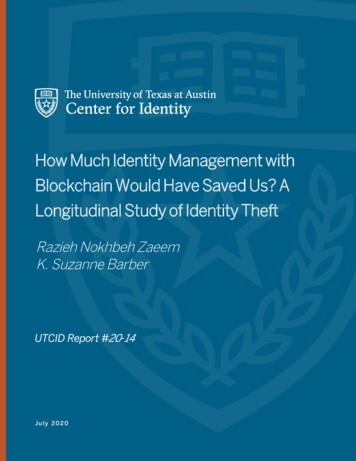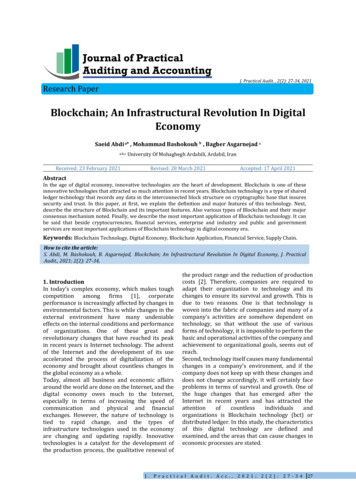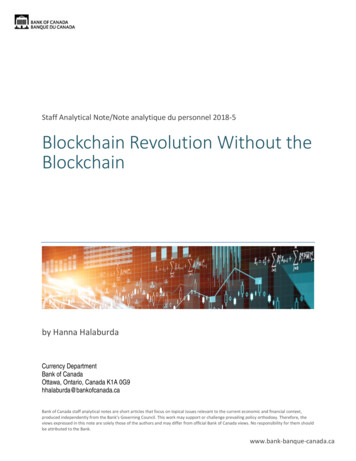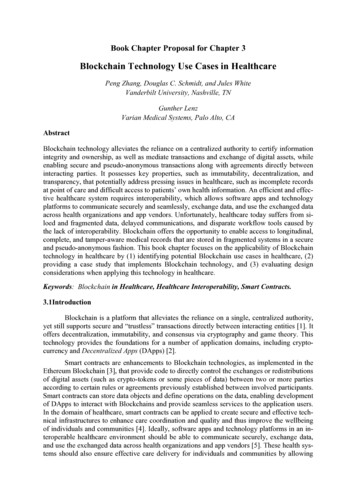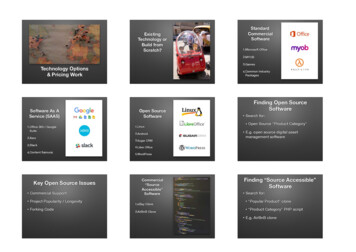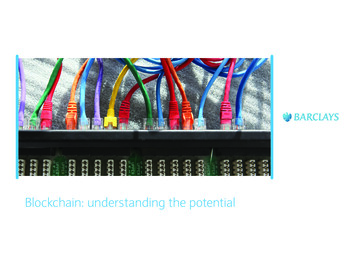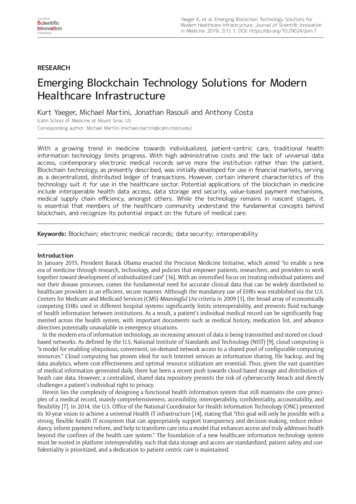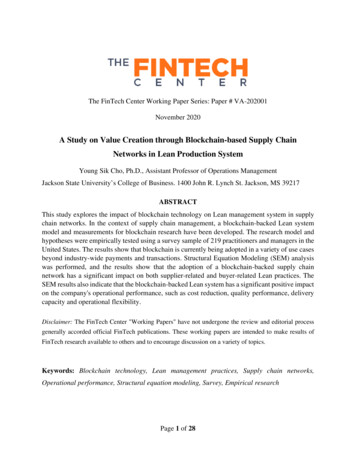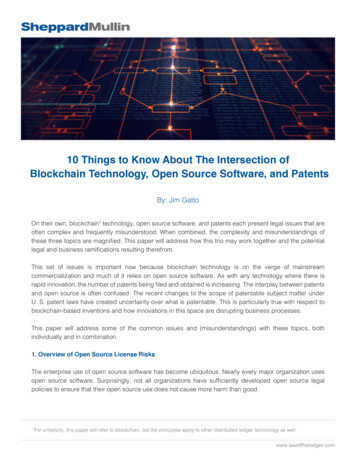
Transcription
10 Things to Know About The Intersection ofBlockchain Technology, Open Source Software, and PatentsBy: Jim GattoOn their own, blockchain1 technology, open source software, and patents each present legal issues that areoften complex and frequently misunderstood. When combined, the complexity and misunderstandings ofthese three topics are magnified. This paper will address how this trio may work together and the potentiallegal and business ramifications resulting therefrom.This set of issues is important now because blockchain technology is on the verge of mainstreamcommercialization and much of it relies on open source software. As with any technology where there israpid innovation, the number of patents being filed and obtained is increasing. The interplay between patentsand open source is often confused. The recent changes to the scope of patentable subject matter underU. S. patent laws have created uncertainty over what is patentable. This is particularly true with respect toblockchain-based inventions and how innovations in this space are disrupting business processes.This paper will address some of the common issues and (misunderstandings) with these topics, bothindividually and in combination.1. Overview of Open Source License RisksThe enterprise use of open source software has become ubiquitous. Nearly every major organization usesopen source software. Surprisingly, not all organizations have sufficiently developed open source legalpolicies to ensure that their open source use does not cause more harm than good.1 For simplicity, this paper will refer to blockchain, but the principles apply to other distributed ledger technology as well.www.lawoftheledger.com
One of the greatest potential legal risks with open source software is the impact it can have on proprietarysoftware. Certain open source licenses require that if other software includes, is derived from, or is combinedwith open source code covered by that license, then when that software is distributed, it must be licensedunder the terms of the open source license. This is referred to as the “tainting” of proprietary software.This often means that licensees can copy, modify, and redistribute that software for free and the sourcecode for that software must be made available to permit the exercise of those rights. This means that if thesoftware developer wanted to be able to license the software under a proprietary license, it cannot. This cansignificantly impact the value of the software and the business itself. Yet, despite this risk, many companiesdo not effectively manage their developer’s use of open source software.2. Misconceptions About Patenting Open Source SoftwareOpen source licenses are primarily copyright licenses that grant licensees the rights to copy, modify, anddistribute computer code. However, there are significant patent issues that can arise with these licenses.We often hear people express the belief that open source software cannot be patented. This is not true.There is no such prohibition. Any software that meets the requirements for patentability can be patented,regardless of how it may be licensed.3. Patent License Grants Triggered by Open Source LicensesMany open source licenses include patent grant provisions that require the licensee to grant an expresspatent license to others. These provisions vary based on a number of parameters. These parameters mayinclude: What triggers a license grant (trigger conditions)—for example, if the licensee modifies, redistributes orcontributes to the open source software? To whom is a license granted—just downstream users or upstream developers as well? What patents are licensed—presently owned patents or future acquired ones as well, patents that coverthe licensors contributions only or future modifications by downstream users as well?Many organizations are surprised to learn that under some open source licenses they must grant (sometimesbroad) patent licenses to patents they own now and those they acquire in the future. Some are surprisedthat the scope of the patent license is not just patents that cover what the organization contributed but todownstream modifications by other users as well.In addition to express patent licenses grants, it can be argued that at least some open source licensestrigger implied patent licenses. This issue is largely unresolved, but at least one court has indicated that opensource licenses can trigger implied licenses.22I n a case involving GPL-licensed code, the court suggested, in ruling on a preliminary motion, that the GPL’s “right to use” licensegrant triggered an implied license at least under the right to “use” under patent law. See Ximpleware, Corp. v. Versata Software, Inc.The court did not opine on the full scope of such an implied license.www.lawoftheledger.com
If patents are important to your business, it is critical to ensure that you understand the scope of the expressand/or implied patent licenses you may be granting by using and contributing to certain open source software.4. Potential Implications of Asserting Patent Claims Against Open Source UsersCertain open source licenses seek to deter licensees from asserting patent infringement claims relating tothe use of open source. These licenses impose a penalty against licensees who make such claims. Thepenalty against such licensees varies by license, but can include loss of patent licenses granted to thelicensee, loss of licensee’s rights to use the open source software, and/or other loss of rights.One thing that has surprised some people is the scope of these penalties. For example, some of theseprovisions are triggered even if the licensee brings a counterclaim for patent infringement. Under somelicenses, the penalty includes licensee’s loss of all rights, including the right to use the open source softwareand any patent licenses that were granted.For more information on these and other patent issues with open source, see our paper on Patent Issues withOpen Source Software.5. Open Source Issues with Nodes and CloudsMost open source license legal issues arise upon “distribution” of the software. Generally, providing networkaccess to software (e.g., via a SaaS or cloud model) is not deemed a distribution, because the user doesnot get a copy of the program or rights to copy, modify, or redistribute it. Thus, the good news for entitiesthat have proprietary software that is accessed via a network is that many of the potentially problematicissues (tainting, patent license grants, etc.) that can arise from use of open source software are non-issuesunder most open source licenses, including the General Public License (GPL). This means that you can runprograms in the cloud that include or are derived from GPL programs and not subject your proprietary codeto the terms of the GPL.However, there are some open source licenses that can trigger these problematic issues when software isaccessed via a network, even if it is not distributed to others. Many organizations know that the Affero GPLtriggers such legal obligations if you provide network access to covered software. However, the Affero GPLis not the only license that may have open source legal implications when providing network access. Someof the other licenses that can raise issues include, but are not limited to: GNU Affero General Public License Open Software License 3.0 (OSL-3.0) Honest Public License (HPL) European Union Public License (EUPL) Apple Public Source License Academic Free License Various Creative Commons Licenseswww.lawoftheledger.com
When using open source software in network accessed deployments, it is imperative to review each of thelicenses that govern the open source components to ensure that there are no unforeseen consequences.This likely will apply to at least some software that runs on blockchain nodes. For example, if open sourcecode is combined with “proprietary” software that is run on a node, users who access this software over anetwork may have a right to the source code as may the node operators to whom you distribute copies.6. Patenting Blockchain TechnologyBlockchain technology is as patentable as any other technology. Despite the recent Alice decision, whichredefined the scope of patentable subject matter, many blockchain patents have been granted and the rateof filing is increasing. As such, many of the technical innovations in this space are being patented. For moreinformation on patenting blockchain technology, see our papers on Drafting Effective Blockchain Patents,Patent Strategies for Cryptocurrencies and Blockchain Technology, and Recent Blockchain Patents of Note.7. Considerations for Open Source Licensing of Blockchain TechnologyMany blockchain-based applications are licensed under open source licenses. Given the distributed natureof many public blockchains, the prevalence of open source licensing makes sense. However, open sourcelicensing will not necessarily be the best option for all aspects of blockchain technology and blockchainbased applications.One thing that helped the internet achieve worldwide adoption was the open source nature of some of theunderlying technology and protocols. So, too, will blockchain adoption benefit from some of the underlyingtechnology and protocols being open source.One ramification of open source code is that others can easily modify and fork the code. In some cases thisis beneficial. In other cases, it leads to fragmentation and may not be as beneficial.For certain private blockchain uses, proprietary software may be preferred. Also, it is likely that manyblockchain-based applications that leverage the underlying (open source) infrastructure may be distributedunder proprietary licenses.In short, there will be some situations where it will be beneficial to use open source licensing and for othersproprietary licensing will be preferable. These are business decisions that will need to be made on a caseby-case basis based on business and legal principles.www.lawoftheledger.com
8. Choice of Open Source License for Blockchain Technology and ApplicationsAssuming a decision is made to distribute particular blockchain software under an open source license, thequestions then becomes which one? There are hundreds of different versions of open source licenses. Thedecision regarding which to use also involves careful consideration of the business and legal issues. Wehave a checklist of issues we address with clients facing this decision. Some of the initial choices to makeare: Restrictive or Permissive License—do you want to ensure the software and improvements remain opensource or should licensees be permitted to use the software in proprietary software? Patent Grant—do you want to grant a patent license to downstream users and/or require them to grantpatent licenses upon further distribution? Scope of Patent Grant—if you include a patent grant provision, what are the trigger conditions for causinga licensee to grant a patent license, who gets the license, and what is the scope of the patents to beincluded?Based on these and other choices, an appropriate license can be selected.9. The Need for Open Source PoliciesEach organization using or distributing software under open source licenses should create and enforcewritten open source policies. These policies should include processes for approving and managing the useand/or distribution of open source software. They should take into account the potential ramifications of opensource licensing on the organization’s patent portfolio, if applicable.For more information on this, see our paper on Open Source Policies — Why You Need Them And What TheyShould Include10. ConclusionThe foregoing is just the tip of the iceberg with respect to the business and legal issues that can arise with theuse of blockchain technology, open source software, and patents. As companies increase the commercialexploitation of blockchain and distributed ledger technology, they would be well served to carefully considerthese issues as a whole. Such consideration should involve consultation with individuals knowledgeable ofthe range of issues as well as the business and legal ramifications that can arise.www.lawoftheledger.com
Sheppard Mullin’s Blockchain Technology and Digital Currency team helps clients develop innovative andcomprehensive legal strategies to take advantage of what may be the most disruptive and transformativetechnology since the Internet. We focus on advising clients on how to meet their business objectives,without incurring unnecessary legal risk. Our team includes attorneys with diverse legal backgrounds whocollectively understand the vast array of legal issues with and ramifications of blockchain technology anddigital currencies. More InformationSheppard Mullin attorneys are at the forefront of the emerging legal issues arising from and risk managementnecessitated by the rapid increase in the use of open source software. We work with business, technicaland legal personnel to provide comprehensive advice regarding all aspects of use and distribution of opensource software and contribution to open source projects. Our team includes software programmers, leadingIP practitioners and experienced software licensing professionals and we have analyzed hundreds of opensource licenses on behalf of clients. Through this extensive experience we have developed a library ofknowledge about open source licenses that cover over 93% of the open source components in use today.More InformationSheppard Mullin offers a complete patent practice, including patent prosecution, licensing and relatedtransactional matters, as well as client counseling. Our patent prosecutors have experience in a range oftechnologies, including pharmaceuticals, software, biologics, electronics, industrial manufacturing, polymers,diagnostics and interdisciplinary technologies such as personalized medicine and medical devices. MoreInformationFor further details on blockchain and digital currency, please contact:James G. GattoLeader, Blockchain Technology and Digital Currency theledger.com
licenses, the penalty includes licensee's loss of all rights, including the right to use the open source software and any patent licenses that were granted. For more information on these and other patent issues with open source, see our paper on Patent Issues with Open Source Software. 5. Open Source Issues with Nodes and Clouds

